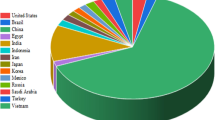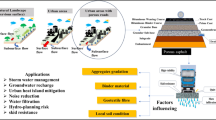Abstract
Facing the lack of limestone materials in some highway construction areas, the reasonable utilization of local raw materials become more and more concerned. To verify the feasibility of replacing limestone aggregate with sandstone in macadam, comparative analysis of appearance and composition between sandstone and limestone is conducted first. Then the mechanical properties, water stability and micro morphology of sandstone concrete are conducted via the compressive strength test, splitting strength test, water stability test and scanning electron microscope (SEM) test. The results showed that irregular polygonal grains and loose structure were in both limestone and sandstone, but limestone has large particles in local pores. All the mechanical properties of sandstone concrete could meet the specification requirements which provided support for alternative some limestone in cement stabilized macadam base. The strength growth rate with less than 4.0% cement content was not obvious. With curing age increasing, the splitting tensile strength of sandstone concrete with different cement content gradually increased, but the strength growth trend slowed down after 28 days. The porosity and water absorption of sandstone were larger than that of limestone, which affected the mechanical properties of sandstone. In addition, the application of sandstone replacing limestone project was evaluated, and the pavement test results verified the feasibility of sandstone concrete in expressway.














Similar content being viewed by others
Data Availability
No data were used to support this study.
References
Narayana, P., Parimi, S., Swathi, P., et al. (2018). A study on suitability of crusher dust stabilized red earth and gravel as subgrade and sub base material[J]. International Journal of Civil Engineering, 5(4), 10–16.
Mustafa, A., Mahmoud, M. A., Abdulraheem, A., et al. (2019). Comparative analysis of static and dynamic mechanical behavior for dry and saturated cement mortar[J]. Materials, 12(20), 3299.
Wang, W., Yang, X., Huang, S., et al. (2019). Experimental study on the shear behavior of the bonding interface between sandstone and cement mortar under Freeze–Thaw[J]. Rock Mechanics and Rock Engineering, 7, 881–907.
Yang, F., Li, H., Zhao, G., et al. (2020). Mechanical performance and durability evaluation of sandstone concrete[J]. Advances in Materials Science and Engineering, 2020(13), 1–10.
Mahanta, B., Ranjith, P. G., Vishal, V., et al. (2020). Temperature-induced deformational responses and microstructural alteration of sandstone[J]. Journal of Petroleum Science and Engineering, 192, 107239.
Šiler, P., Bezděk, O., Kolářová, I., et al. (2014). The influence of aggregates on the properties of concrete[J]. Advanced Materials Research, 1000, 277–280.
Petrounias, P., Giannakopoulou, P., et al. (2018). The effect of petrographic characteristics and physico-mechanical properties of aggregates on the quality of concrete[J]. Minerals, 8(12), 557–578.
Liev L, Hendrych J, Kunick R, et al. 2018 Evaluation of Sandstone Internal Structure with Application of Micro-CT and FOTOM System[C]// International Conference on Intelligent Information Technologies for Industry. 680: 332–339.
Dong, Y., Yang, H., Zhang, L., et al. (2014). Effects of aggregate interface characteristics on the mechanical property of concrete[J]. Journal of Building Materials, 17(04), 598–605.
Mohmmad, A., Vinayak, G., Harsh, C., et al. (2018). Performance evaluation of cement concrete containing sandstone slurry[J]. Construction & Building Materials, 184(SEP.30), 432–439.
Mundra, S., Agarwal, V., & Nagar, R. (2020). Sandstone cutting waste as partial replacement of fine aggregates in concrete: a mechanical strength perspective[J]. Journal of Building Engineering, 32, 101534.
Kumar, S., Gupta, R. C., & Shrivastava, S. (2017). Long term studies on the utilisation of quartz sandstone wastes in cement concrete[J]. Journal of Cleaner Production, 143(FEB.1), 634–642.
Fontanini, P., Pimentel, L. L., Jacintho, A. E., et al. (2013). Brazilian geological sandstone characterization and its utilization as aggregate in structural concrete[J]. Applied Mechanics & Materials, 271–272, 141–146.
Yilmaz, M., & Tugrul, A. (2012). The effects of different sandstone aggregates on concrete strength[J]. Construction and Building Materials, 35, 294–303.
Li SL, Zhang H, Gai WP. 2017 Application of sandstone concrete in pavement base course[J]. Highway traffic science and technology. 13(07): 8–10.
Liu, G., Ye, D., Liang, X., et al. (2020). Study on microstructure mechanism of sandstone based on complex network theory[J]. Journal of Measurements in Engineering, 8(1), 27–33.
Fang, Q. U. (2019). Microscopic characteristics of deformation band in porous sandstone and its characterization of deformation mechanism[J]. Acta Geologica SINICA (English edition), 93(z2), 311–312.
Liu, W. B., Cai-Rong, L. U., Mei, G. X., et al. (2014). Preparation and performance of roller compacted concrete with soft sandstone aggregate[J]. The Ocean Engineering, 32(6), 105–110.
Yu, M., Chang, X., & Chen, S. (2018). Analysis of factors affecting the compressive strength of cement stabilized gravel[C]//IOP Conference Series: Materials Science and Engineering. IOP Publishing, 381(1), 012030.
Liu, S. L., Chen, H. R., Yuan, S. S., et al. (2020). Experimental investigation and micromechanical modeling of the brittle-ductile transition behaviors in low-porosity sandstone[J]. International Journal of Mechanical Sciences, 179, 105654.
Man-Sheng MA. The application of cement stabilized gravel base construction technology in highway engineering[J]. Construction and Design for Engineering, 2019(04):213–214.
Vishalakshi, K. P., Revathi, V., & Reddy, S. S. (2018). Effect of type of coarse aggregate on the strength properties and fracture energy of normal and high strength concrete[J]. Engineering Fracture Mechanics, 194, 52–60.
Zhou, X. H. (2018). A feasibility study of a kind of sandstone crushed stone used in cement stabilization graded crushed stone base of a national highway[J]. Southwest Highway., 01, 56–58.
Ji, X., Wang, T., Zhou, Z., et al. (2018). Mechanical and fatigue properties as well as strength criteria of cement stabilized gravel produced by vibration compaction method[J]. Journal of Building Materials, 21(5), 761–767.
Kumar, S., Gupta, R. C., & Shrivastava, S. (2016). Strength, abrasion and permeability studies on cement concrete containing quartz sandstone coarse aggregates[J]. Construction & Building Materials, 125(OCT.30), 884–891.
Dan, L. Z., Chen, F., Chen, F., et al. (2018). Road performance study of cement stabilized gravel mixture based on vibratory mixing technology[J]. Technology of Highway and Transport, 34(05), 21–26.
Zhou, Z. L., Cai, X., Zhao, Y., et al. (2016). Strength characteristics of dry and saturated rock at different strain rates[J]. Transactions of Nonferrous Metals Society of China, 26(7), 1919–1925.
Ince, R., & Cetin, S. Y. (2019). Effect of grading type of aggregate on fracture parameters of concrete[J]. Magazine of Concrete Research, 71(15–16), 860–868.
Dabrowski, M., & Glinicki, M. A. (2012). Influence of aggregate type on the durability of concrete made of blended cements with calcerous fly ash[J]. Brittle Matrix Composites, 10, 305–313.
Li, H., Wang, W., Li, W., et al. (2019). Replacement of limestone with volcanic stone in asphalt mastic used for road pavement[J]. Arabian Journal for Science and Engineering, 44(10), 8629–8644.
Du, Q., Pan, T., Lv, J., et al. (2019). Mechanical properties of sandstone cement-stabilized macadam[J]. Applied Sciences, 9(17), 3460.
Li, H., Wang, J., Li, J., et al. (2004). Mechanical properties of soft rock under dynamic uniaxial compression[J]. Rock. Soil. Mech, 25(1), 1–4.
Ma, Q. (2016). Research on key technology for material design of cement stabilized sandstone gravel[J]. Road Machinery & Construction Mechanization, 33(01), 48–50.
Yang, F., Li, H., Zhao, G., et al. (2020). Mechanical performance and durability evaluation of sandstone concrete[J]. Advances in Materials Science and Engineering, 2020, 1–10.
Author information
Authors and Affiliations
Corresponding author
Ethics declarations
Conflict of Interest
The authors declare that they have no conflict of interest.
Rights and permissions
About this article
Cite this article
Li, H., Guo, X., Xin, J. et al. Study on the Characteristics of Sandstone and Feasibility to Replace Limestone in Cement Stabilized Macadam Base. Int. J. Pavement Res. Technol. 16, 1419–1438 (2023). https://doi.org/10.1007/s42947-022-00206-6
Received:
Revised:
Accepted:
Published:
Issue Date:
DOI: https://doi.org/10.1007/s42947-022-00206-6




